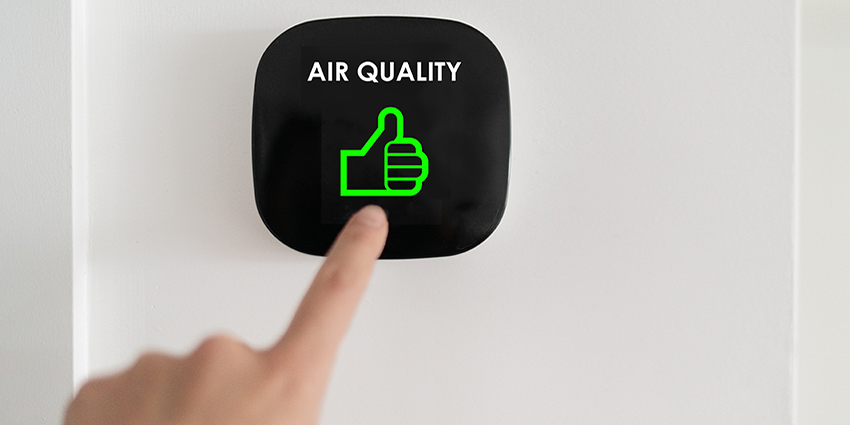Three Tactics to Improve Indoor Air Quality (IAQ) in Schools and Commercial Buildings

A well-designed and maintained HVAC system often is the best solution to ensure healthy air quality indoors. Unfortunately, many HVAC systems in schools fall short of this criteria. The Government Accountability Office (GAO) reports that 40% or about 36,000 school districts need to update or replace current HVAC equipment.
The good news is that elementary and high schools have an opportunity to improve IAQ. Stimulus money from the Elementary and Secondary School Emergency Relief (ESSER) fund is available. Nearly $190.5 billion in funds allow for maintenance and upgrades to school HVAC systems to help mitigate the spread of COVID-19 and improve IAQ.
With money available, the question of how to proceed remains.
Options for maintaining and upgrading HVAC systems should follow U.S. Centers for Disease Control and Prevention (CDC) guidelines. The CDC further recommends HVAC systems reference guidance from the American Society for Heating, Refrigerating and Air-Conditioning Engineers (ASHRAE). ASHRAE 62.1 outlines the functions a well-designed and maintained HVAC system should have to maximize IAQ and lessen the effects of pathogen risks.
Three Foundational Tactics to Consider
- Ventilation – Ventilation brings fresh and conditioned outdoor air into a building. It plays a major role in ensuring proper IAQ and assists the HVAC system in removing contaminants from a building’s atmosphere. However, ventilation tactics established before COVID do not work well in lessening the spread of diseases like COVID or the flu. How that outdoor air gets introduced into the building to mitigate the COVID risk involves a slightly different use of ventilation equipment.
The ASHRAE 62.1 standard offers minimum ventilation requirements based on the number of occupants and size of the space. That is about 20 cfm per person in most commercial and office buildings, with air changes per hour between two and six, depending on the space. Others, such as University of Illinois MechSE Professor Emeritus Ty Newell, suggest doubling the minimum ventilation rate.
Consider disabling demand control equipment controlling the number of air changes in a building based on occupancy. Disabling the controls allows the maximum amount of outdoor air, no matter how many people are in the building.
Run the HVAC system continuously when people are in the building. This action prevents any contaminant buildup.
Flush the air every day. Run your HVAC system longer—before people arrive and after everyone leaves—to provide fresh air without allowing time for contaminants to linger.
- Effective air distribution – A subset of ventilation is effective air distribution. A simplified explanation of this is the ability to move air throughout a building to ensure air is blended evenly from ceiling to floor while not permitting pathogens to form in spaces where airflow inconsistencies exist.
Most mechanical ventilation systems force fresh air into a room or building through ducts. Supply grilles or registers at the end of those ducts diffuse and disperse the fresh air, while return grilles and registers remove the contaminated air. Unfortunately, too few or improperly placed supply and return grilles may not address the challenge of effective air distribution.
One option is to add more supply and return grilles/registers. Equipment such as overhead fans—also called high volume low speed (HVLS) fans—also assist in providing even airflow distribution to a building space. The fan also minimizes areas where airflow is low, allowing contaminants to collect.
- Effective air distribution – A subset of ventilation is effective air distribution. A simplified explanation of this is the ability to move air throughout a building to ensure air is blended evenly from ceiling to floor while not permitting pathogens to form in spaces where airflow inconsistencies exist.
- Filtration – Filtering the air removes smaller particles of airborne particulates including viruses. Your HVAC system has filters in it, but the filter type and how often you replace the filter matters. Filters use a minimum efficiency reporting value, or MERV rating, to determine its effectiveness in removing contaminants in the air. A MERV 8 filter will remove larger particles (dust or pollen) but not smaller particles. The MERV 13 rated filter removes smaller particles and can catch about 85% of airborne particles that are harmful to your health.
Filtration does have a potential drawback, however. Filters better able to catch airborne pathogens and contaminants also place an increased strain on airflow (HVAC systems) by causing fans to run faster. It’s always a good idea to check if your HVAC system can tolerate this increased stress before using higher efficiency filters.
- Humidification – Overly dry or humid conditions inside a building can cause annoyances such as static electricity to more serious issues like mold. However, a middle range produces a very comfortable and productive environment. ASHRAE recommends a relative humidity between 40% - 60%. More importantly, relative humidity in that range may reduce the potential for airborne viral transmission.
Information about additive air cleaning technologies has made news in light of COVID. Many claims and promises abound regarding these technologies. However, while technology such bipolar ionization (BPI) show promise, studies are not complete and do not confirm these claims at this time. You should always review studies from manufacturers and third-party certifying organizations to ensure this equipment functions as promoted.
Importance of Energy Efficiency
Proper ventilation often is expensive. HVAC systems account for about 40% of the energy cost for commercial buildings. The expense is why ventilation before the COVID pandemic focused on energy efficiency. Ensuring proper ventilation for IAQ and health safety now ranks ahead of energy costs. This change in emphasis, however, does not diminish the importance of energy efficiency. Changing or upgrading HVAC systems should still meet current guidelines. ASHRAE offers minimum energy efficiency requirements (ASHRAE 90.1) for building design and local energy codes.
These three tactics related to IAQ and COVID reduction provide you a starting point in discussing options for making your building—whether a school, office, warehouse, or other commercial building—a healthy place. The next step should be consulting with experienced HVAC engineers or contractors who understand CDC ventilation guidelines, along with ASHRAE standards 62.1 and 90.1.
The other consideration is determining which HVAC equipment makes sense for your building. You want to make it perform as promised (and expected). Independent third-party certification programs, like that of the Air Movement and Control Association, International, Inc. (AMCA) provide this assurance that the HVAC equipment you choose performs as specified. Learn more about products, IAQ and mitigating the spread of contagious diseases in school buildings.
Read Next
How to Adjust Your HVAC System and Minimize the Spread of COVID-19
The Impact of Poor Indoor Air Quality in Multifamily Buildings


from